2523ss05
2523ss05.docx
Standards of Performance for New, Reconstructed, and Modified Sources and Emissions Guidelines for Existing Sources: Oil and Natural Gas Sector Climate Review (Supplemental Proposed Rule)
OMB: 2060-0721
SUPPORTING STATEMENT
Standards of Performance for Crude Oil and Natural Gas Facilities for which Construction, Modification or Reconstruction Commenced After November 15, 2021.
(40 CFR part 60, subpart OOOOb)
PART A
1.0 Identification of the Information Collection
(a) Title and Number of the Information Collection.
The title of the Information Collection Request (ICR) is Standards of Performance for Crude Oil and Natural Gas Facilities for Construction, Modification, or Reconstruction Commenced After November 15, 2021 (with the exception of centrifugal compressor affected facilities equipped with dry seals) (40 CFR part 60, subpart OOOOb), U.S. Environmental Protection Agency (EPA) tracking number is 2523.05, Office of Management and Budget (OMB) Control Number 2060-0721. Centrifugal compressor affected facilities that use dry seals are subject to the applicable provisions of this subpart if construction, modification, or reconstruction is commenced after the date of publication of the supplemental proposal in the Federal Register.
(b) Short Characterization.
This supplemental proposal is issued for the Standards of Performance for New, Reconstructed, and Modified Sources and Emissions Guidelines for Existing Sources: Oil and Natural Gas Sector Climate Review to update, strengthen, and expand the standards proposed on November 15, 2021 (November 2021 proposal), for methane and volatile organic compound (VOC) emissions. First, the EPA proposes to reduce emissions from the source category more comprehensively by adding proposed standards for certain sources that were not addressed in the November 2021 proposal, revising the proposed requirements for fugitive emissions monitoring and repair, and establishing a super-emitter response program. Second, the EPA proposes revisions to the alternative standards for fugitive emissions monitoring and repair that would encourage the deployment of innovative technologies and techniques for detecting and reducing methane emissions by providing additional options for the use of advanced monitoring. Third, the EPA proposes to modify and refine certain elements of the proposed standards in response to concerns and information submitted in public comments on the November 2021 proposal. Finally, the EPA provides additional information not included in the November 2021 proposal for public comment, such as the proposed regulatory text for the new subpart.
This ICR reflects the EPA’s proposed new source performance standards (NSPS) for a wide range of emissions sources in the Crude Oil and Natural Gas source category (to be codified in 40 CFR part 60 subpart OOOOb). The information collected will be used by the EPA and delegated state and local agencies to determine the compliance status of affected facilities subject to the rule. Some of the proposed standards resulted from the EPA’s review of the current NSPS codified at 40 CFR part 60 subpart OOOOa (NSPS OOOOa), while others were proposed standards for additional emissions sources that are currently unregulated.
The respondents include owners or operators of onshore oil and natural gas affected facilities (40 CFR 60.5365b) and third-party entities that voluntarily apply to become certified to provide documented identified of a super-emitter emissions event. For the purposes of this ICR, it is assumed that oil and natural gas affected facilities located in the United States are owned and operated by the oil and natural gas industry (the “Affected Public”), and that none of the affected facilities in the United States are owned or operated by state, local, tribal or the Federal government. All affected facilities are assumed to be privately owned for-profit businesses.
The EPA estimates an average of 1,849 respondents will be affected by NSPS OOOOb over the three-year period (2023-2025). The average annual burden for the recordkeeping and reporting requirements for these owners and operators is 883,625 person-hours, with an average annual cost of $58,474,899over the three-year period (2023-2025).
2. Need For and Use of the Collection
(a) Need/Authority for the Collection.
The EPA is charged under section 111 of the Clean Air Act (CAA), as amended, to establish standards of performance for new stationary sources that reflect:
. . . application of the best technological system of continuous emissions reduction which (taking into consideration the cost of achieving such emissions reduction, or any non-air quality health and environmental impact and energy requirements) the Administrator determines has been adequately demonstrated. Section 111(a)(l).
The Agency refers to this charge as selecting the best system of emissions reduction (BSER). Section 111 of the CAA also requires that the Administrator review and, if appropriate, revise such standards every 8 years.
In addition, section 114(a) of the CAA states that the Administrator may require any owner or operator subject to any requirement of this Act to:
establish and maintain such records;
make such reports;
install, use, and maintain such monitoring equipment;
use such audit procedures, or methods;
sample such emissions (in accordance with such procedures or methods, at such locations, at such intervals, during such periods, and in such manner as the Administrator shall prescribe);
keep records on control equipment parameters, production variables or other indirect data when direct monitoring of emissions is impractical;
submit compliance certifications in accordance with section 114(a)(3) of the CAA; and
provide such other information as the Administrator may reasonably require.
The information collection activities under the proposed NSPS OOOOb are necessary for the Administrator to confirm the compliance status of new and modified oil and natural gas affected facilities. These recordkeeping and reporting requirements are authorized by CAA section 114.
(b) Practical Utility/Users of the Data.
The information will be used by the delegated authority (state agency, or Regional Administrator if there is no delegated state agency) to ensure that the standards and other requirements of NSPS OOOOb are being achieved. Based on review of the recorded information at the site and the reported information, the delegated permitting authority can identify affected facilities that may not be in compliance and decide which affected facilities, records, or processes may need inspection.
3. Nonduplication, Consultations, and Other Collection Criteria
(a) Nonduplication.
No other regulation currently requires the same information under this ICR from owners/operators subject to the requirements of this subpart. In the event that certain reports required by state or local agency may duplicate information required by this subpart, a copy of the report submitted to the state or local agency can be sent to the Administrator in lieu of the report required by the Federal standards.a Therefore, no duplication exists.
(b) Public Notice Required Prior to ICR Submission to OMB.
The preamble for the proposed NSPS OOOOb provides public notice of this proposed ICR. The EPA will consider comments when preparing the final ICR. The preamble to the final rule will provide public notice on the revised ICR.
(c) Consultations.
In developing the proposed NSPS OOOOb, the EPA performed a comprehensive review of existing state rules and industry standards, consulted with individual companies and trade organizations, state agencies, and environmental groups, and consider public comments from a variety of interests. The main organizations that provided expert advice during the development of this rule include the Agency’s industry experts.
(d) Effects of Less Frequent Collection.
Respondents must monitor all specified criteria at each affected facility and maintain these records for 2 years, as specified under 40 CFR 60.7. The reporting frequency to the EPA has been established/amended to minimize the burden on owners and operators of affected facilities. If the information required by NSPS OOOOb were collected less frequently, the likelihood of detecting violations would be reduced.
(e) General Guidelines.
This collection of information is consistent with all OMB guidelines established by OMB at 5 CFR part 1320, section 1320.5.
(f) Confidentiality.
All information submitted to the Agency for which a claim of confidentiality is made will be safeguarded according to the EPA regulations set forth in 40 CFR 2.201 et seq., Chapter 1, Part 2, Subpart B-Confidentiality of Business Information.
(g) Sensitive Questions.
This section is not applicable because this ICR does not involve matters of a sensitive nature.
4. The Respondents and the Information Requested
(a) Respondents/NAICS Codes.
Potential respondents under NSPS OOOOb are owners or operators of new, modified or reconstructed oil and natural gas affected facilities as defined under the rule and third-party entities that are interested in applying for certification as a notifier of super-emitter emissions events. The North American Industry Classification System (NAICS) codes for the oil and gas industry include: 211120 (Crude Petroleum Extraction); 211130 (Natural Gas Extraction); 221210 (Natural Gas Distribution); 486110 (Pipeline Distribution of Crude Oil); and 486210 (Pipeline Transportation of Natural Gas).
(b) Information Requested.
(i) Data Items, Including Recordkeeping Requirementsb
(ii) Respondent Activities.
Respondent Activities |
Read instructions/rule. |
Gather relevant information. |
Perform initial performance test and repeat performance tests if necessary. |
Write the notifications and reports listed above. |
Enter information required to be recorded above. |
Submit the required reports developing, acquiring, installing, and utilizing technology and systems for the purpose of collecting, validating, and verifying information. |
Develop, acquire, install, and utilize technology and systems for the purpose of processing and maintaining information. |
Develop, acquire, install, and utilize technology and systems for the purpose of disclosing and providing information. |
Adjust the existing ways to comply with any previously applicable instructions and requirements. |
Train personnel to be able to respond to a collection of information. |
Transmit, or otherwise disclose the information. |
5. The Information Collected–Agency Activities, Collection Methodology, and Information Management
(a) Agency Activities.
The federal government (EPA) activities associated with the proposed amendments to NSPS OOOOb are provided in Tables 2a-2d (located at the end of this supporting statement) and are introduced in section 6(c).
(b) Collection Methodology and Management.
Data and records maintained by the respondents for semiannual and annual reports are tabulated and published for use in compliance and enforcement programs of the delegated permitting authority. Information contained in the reports will be required to be submitted electronically to EPA’s Central DATA Exchange (CDX) using the CEDRI. CDX enables fast, efficient and more accurate environmental data submissions from state and local governments, industry and tribes to EPA and participating program offices. EPA’s CDX is the point of entry on the Environmental Information Exchange Network (Exchange Network) for environmental data submissions to the Agency. CDX works with both EPA program offices looking for a way to better manage incoming data, and stakeholders looking for a way to reduce burden from reporting requirements. Appendix B includes the CEDRI electronic portal for submitting reports under 40 CFR part 60, subpart OOOOb. The electronic portal to submit reports online is accessed through the EPA’s CDX at https://cdx.epa.gov. The spreadsheet templates created by the EPA to facilitate annual reporting for Oil and Gas Facilities under 40 CFR part 60, subpart OOOOb can be obtained at https://www.epa.gov/electronic-reporting-air-emissions/cedri#list as well as https://www.epa.gov/controlling-air-pollution-oil-and-natural-gas-industry/implementation-oil-and-natural-gas-air#report.
For super-emitter emissions events, the EPA will establish a separate website where it will make notifications of super-emitter emissions events and reports, in response to those notifications, publicly available. That website has not yet been established but will be provided at a later date.
(c) Small Entity Flexibility.
The EPA performed a screening analysis for impacts on a sample of expected affected small entities by comparing compliance costs to entity revenues. The impact on small entities (i.e., small businesses) was taken into consideration during the development of the regulation. The EPA has tried to reduce the impact of this proposed rule on small entities by specifying monitoring, recordkeeping and reporting requirements that are the minimum necessary to ensure compliance.
(d) Collection Schedule.
The specific frequency for each information collection activity within this request is shown in Tables 1a-1d.
6. Estimating the Burden and Cost of the Collection
(a) Estimating Respondent Burden.
The annual burden estimates for the proposed NSPS OOOOb are shown in Tables 1a-1d. These numbers are based on the estimated number of affected facilities that would be subject to the requirements of the NSPS from years 2023 to 2025.
(b) Estimating Respondent Costs.
(i) Estimating Labor Costs.
This ICR uses the following labor rates: $49.56 per hour for technical labor, $120.52 per hour for management labor, and $47.40 for clerical labor. These rates include an increase of 110 percent to account for the benefit packages available to those employed by private industry. These rates are from the May 2021 National Occupational Employment and Wage Estimates United States published by the Bureau of Labor and Statistics (https://www.bls.gov/oes/current/oes_nat.htm). Costs have been estimated in 2019 dollars for this ICR, which is consistent with the costs (i.e., cost of control) estimated in the supporting documents developed for the proposed NSPS OOOOb.
The information collection activities for NSPS OOOOb are presented in Tables 1a-1d. Because the data are already collected by respondents as part of normal operations, no respondent costs are associated with information collection activities.
(ii) Estimating Capital and Operations and Maintenance (O&M) Costs.
A significant capital cost component to the fugitives monitoring program, is the cost and set-up of a recordkeeping system database. The recordkeeping system database is a key part of the fugitives monitoring program where regular Audio, Visual and Olfactory (AVO) and optical gas imaging (OGI) monitoring is required. Because extensive records are required for each fugitive emissions survey that is conducted it is critical that an appropriate data management system is used in order to manage the compliance data collected. The capital cost associated with the initial set-up of the database recordkeeping system was estimated at $19,728. This one-time cost is accounted for in the first-year capital costs for each new well site with two or more wellheads that is subject to quarterly AVO and semiannually OGI monitoring, well sites and centralized production facilities with major production and processing equipment subject to bimonthly AVO and quarterly OGI monitoring, and compressor stations subject to monthly AVO and quarterly OGI monitoring. Consistent with the analyses used for the 2016 NSPS OOOOa and 2020 Technical Rule, the EPA assumes that each company will develop a monitoring plan and recordkeeping system that covers a company-defined area, which is assumed to include 22 well sites, 7 gathering and boosting stations, or one transmission or storage station. This assumption is used because there are several elements of the fugitive monitoring program that are not site-specific. Under the proposed OOOOb, single wellhead only well sites and small well sites are subject to quarterly AVO monitoring only and would be required to develop a simple spreadsheet in order to track inspections.
(c) Estimating Agency Burden and Cost.
Because reporting and recordkeeping requirements on the part of the respondents are required under the operating permits rules in 40 CFR part 70 or part 71 and the part 60 NSPS General Provisions, no operational costs will be incurred by the Federal Government. Examination of records to be maintained by the respondents will occur incidentally as part of the periodic inspection of facilities that is part of EPA’s overall compliance and enforcement program, and, therefore, is not attributable to the ICR. The only costs that the Federal government will incur are user costs associated with the analysis of the reported information, as presented in Tables 2a-2d.
This cost is based on the average hourly labor rate as follows:
Managerial $70.56 (GS-13, Step 5, $44.10 + 60%)
Technical $52.37 (GS-12, Step 1, $32.73 + 60%)
Clerical $28.34 (GS-6, Step 3, $17.71 + 60%)
These rates are from the Office of Personnel Management (OPM), 2022 General Schedule rates of pay, which excludes locality. The rates have been increased by 60 percent to account for the benefit packages available to government employees.
(d) Estimating the Respondent Universe and Total Burden and Costs.
It was estimated that an average of 1,849 respondents per year will be subject to NSPS OOOOb during the 3-year period of this ICR as shown in the following table below. This estimate encompasses the number of companies that the EPA expects will submit reports on behalf of all its well sites (Note: each company is assumed to own 22 well sites, 7 gathering and boosting stations, or one transmission or storage station), and the number of third-party entities that the EPA expects will apply to be certified as notifiers of super-emitter emissions events. The average annual number of respondents per year is calculated using the following table.
Yearc |
Annual Number of Respondents |
1 (2023) |
1,238 |
2 (2024) |
1,858 |
3 (2025) |
2,450 |
Average |
1,849 |
For the NSPS OOOOb, the components of the total annual responses attributable to this ICR are notifications of well completions/recompletions from an estimated average of 12,693 companies over the three-year period, notification of construction, reconstruction and modification from an average of 16 companies over the three-year period, annual reports from an average of 1,810 companies over the three-year period, and semiannual reports from an average of 34 companies over the three-year period. (Processing facilities report semiannually, all others annually).
The average number of annual responses per year is calculated using the following table.
Total Annual Responses |
|||
Information Collection Activity |
Number of Respondentsa |
Number of Responses |
Total Annual Responses |
Notification of well completions/recompletions |
12,693 |
1 |
12,693 |
Notification of construction/ reconstruction/modification |
16 |
1 |
16 |
Annual Compliance Reports |
1,810 |
1 |
1,810 |
Semiannual Compliance Reports |
34 |
2 |
68 |
Application for Certification of Third Party for Super-Emitter Response Program |
5 |
1 |
5 |
Third Party Notification of Super-Emitter Emissions Events |
250 |
1 |
250 |
Total |
14,841 |
||
aThe EPA assumes each facility will make the appropriate notifications and that each respondent will submit the annual or semiannual report for all affected facilities in each year.
bPer §60.5420b(a)(2), notifications are required for each well completion/recompletion. Therefore, the estimated number of respondents is based on the estimated number of well completions/recompletions.
(e) Bottom Line Burden Hours and Cost Tables.
(i) Respondent tally. The bottom-line respondent burden hours and costs for the three years (2023-2025) covered by this ICR are presented in Table 1d (located at the end of this supporting statement). The average annual burden for the recordkeeping and reporting requirements in NSPS OOOOb for the estimated 1,849 respondents that are subject to the rule is 883,625 labor hours, with an annual average labor cost of $58,474,899.
(ii) The Agency Tally. The average annual Federal Government cost is $733,461for 14,362 labor hours for NSPS OOOOb. The bottom-line Agency burden hours and costs, presented in Table 2d, are calculated from Tables 2a-2c by adding person-hours per year down each column for technical, managerial, and clerical staff, and by adding down the cost column.
(iii) Variations in the annual bottom line. This section does not apply since no significant variation is anticipated.
(f) Reasons for Change in Burden.
This section does not apply because this is a new ICR.
(g) Burden Statement
The annual public reporting and recordkeeping burden for this collection of information is estimated to average 60 hours per response. Burden means the total time, effort, or financial resources expended by persons to generate, maintain, retain, or disclose or provide information to or for a Federal agency. This includes the time needed to review instructions; develop, acquire, install, and utilize technology and systems for the purposes of collecting, validating, and verifying information, processing and maintaining information, and disclosing and providing information; adjust the existing ways to comply with any previously applicable instructions and requirements; train personnel to be able to respond to a collection of information; search data sources; complete and review the collection of information; and transmit or otherwise disclose the information.
An agency may not conduct or sponsor, and a person is not required to respond to, a collection of information unless it displays a valid OMB Control Number. The OMB Control Numbers for EPA regulations are listed at 40 CFR part 9 and 48 CFR chapter 15.
To view comments received on the Agency’s need for this information, the accuracy of the provided burden estimates, and any suggested methods for minimizing respondent burden, including the use of automated collection techniques, the EPA has established a public docket for this ICR under Docket ID Number [EPA-HQ-OAR-2021-0317]. An electronic version of the public docket is available at http://www.regulations.gov/ which may be used to obtain a copy of the collection of information, view public comments submitted, access the index listing of the contents of the docket, and to access those documents in the public docket that are available electronically. When in the system, select “search,” then key in the docket ID number identified in this document. The documents are typically available for public viewing at EPA Docket Center Room 3334, EPA WJC West Building, 1301 Constitution Ave., NW, Washington, DC. EPA Docket Center Public Reading Room is open from 8:30 a.m. to 4:30 p.m., Monday through Friday, excluding legal holidays. The telephone number for the Public Reading Room is (202) 566-1744, and the telephone number for the EPA Docket Center is (202) 566-1742.
PART B
This section is not applicable because statistical methods are not used in data collection associated with the final rule.
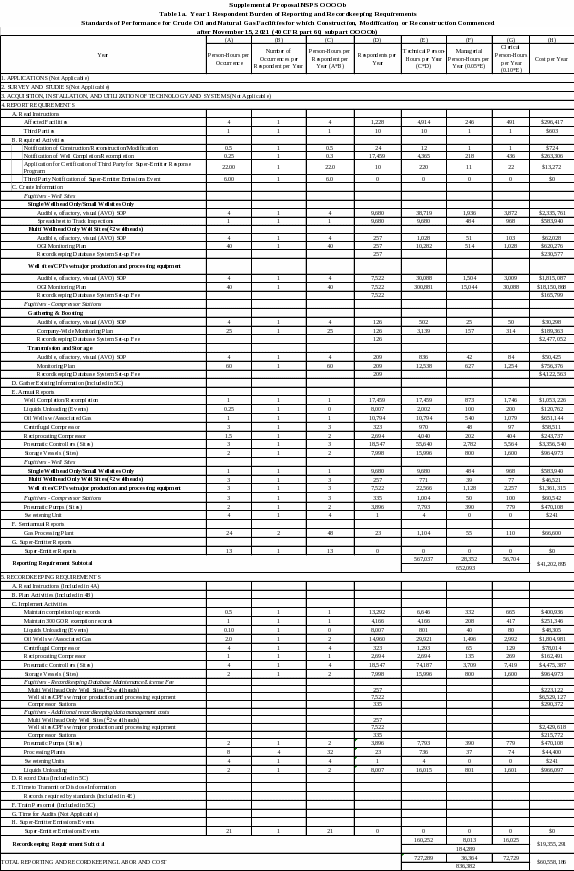
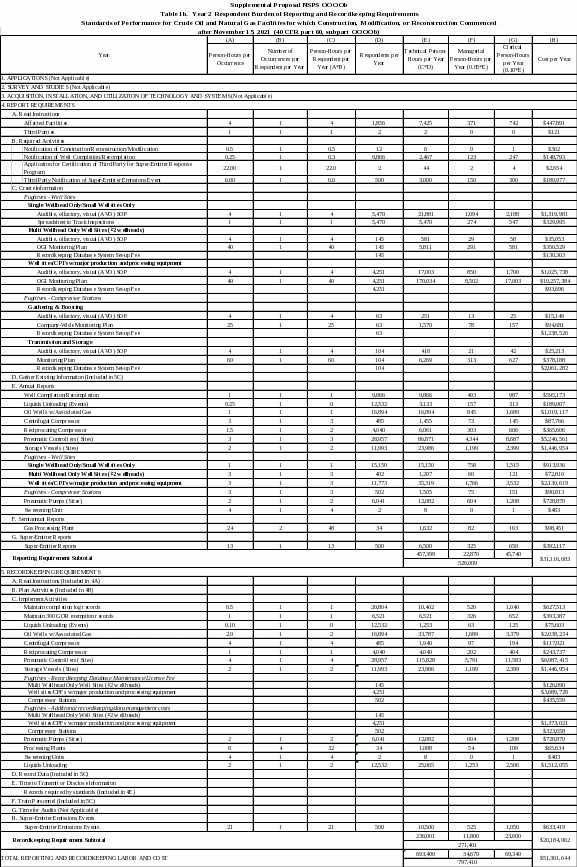


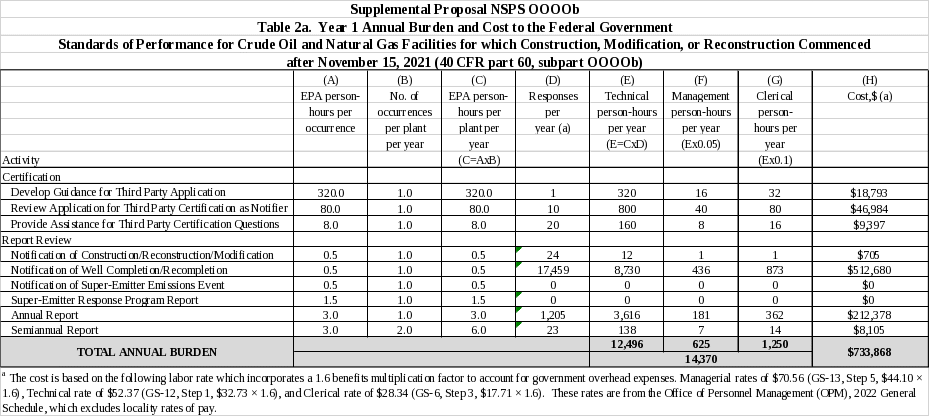
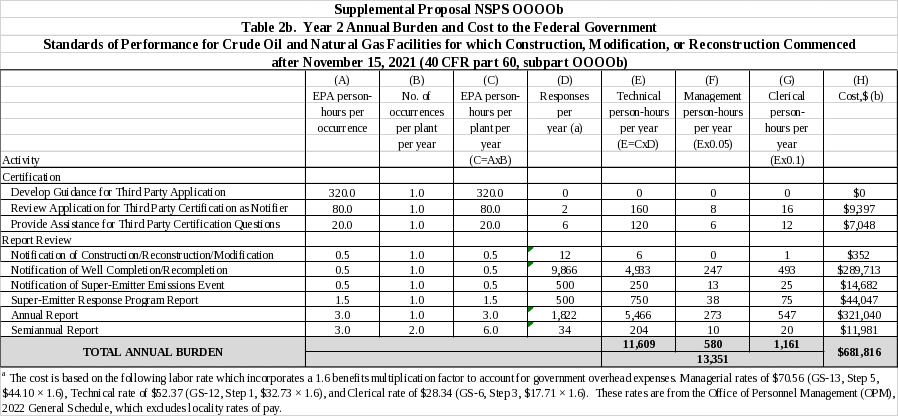
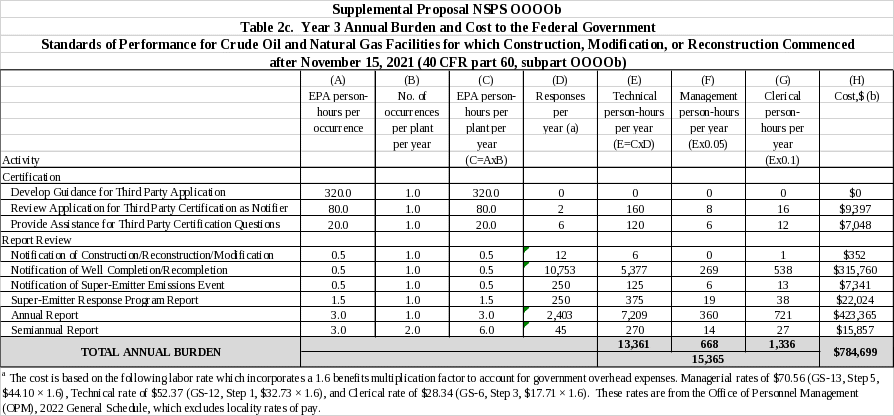

Appendix A
Estimate of New Sources Affected for purposes of the Information Collection Request under the Proposed to 40 CFR part 60, subpart OOOOb.
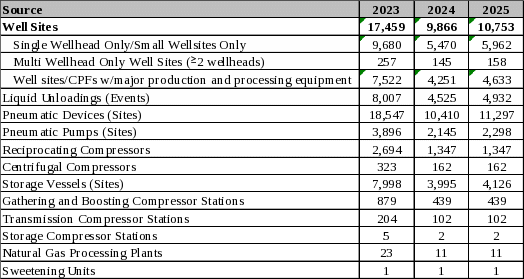 Appendix
B
Appendix
B
EPA’s
Compliance and Emissions Data Reporting (CEDRI) Interface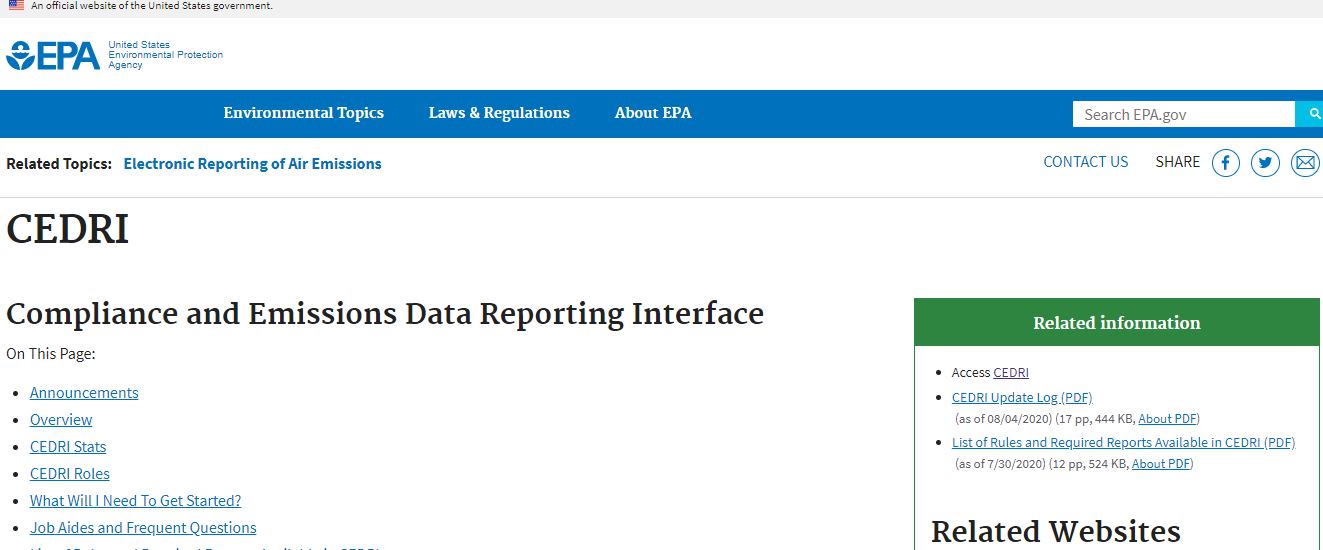
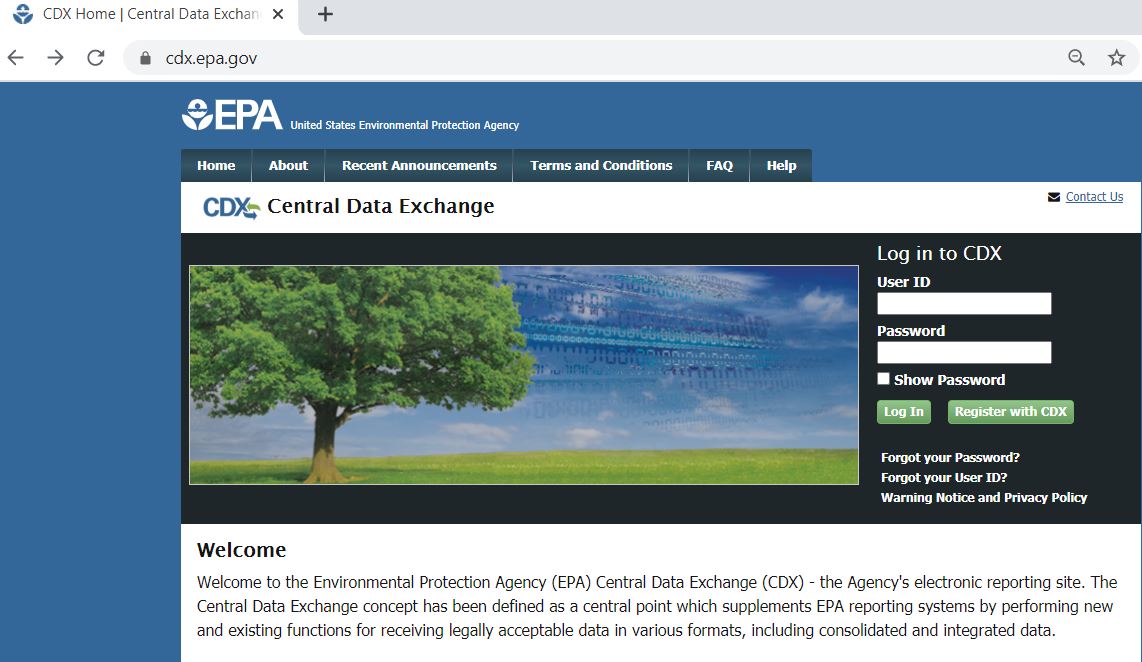
Appendix C
Instructions for submitting reports to the EPA via CEDRI per 60.5420b(c)(11):
(11) You must submit reports to the EPA via CEDRI, except as outlined below. (CEDRI can be accessed through the EPA's CDX (https://cdx.epa.gov/).) The EPA will make all the information submitted through CEDRI available to the public without further notice to you. Do not use CEDRI to submit information you claim as CBI. Anything submitted using CEDRI cannot later be claimed CBI. You must use the appropriate electronic report in CEDRI for this subpart or an alternate electronic file format consistent with the extensible markup language (XML) schema listed on the CEDRI website (https://www.epa.gov/electronic-reporting-air-emissions/cedri/). If the reporting form specific to this subpart is not available in CEDRI at the time that the report is due, you must submit the report to the Administrator at the appropriate address listed in §60.4. Once the form has been available in CEDRI for at least 90 calendar days, you must begin submitting all subsequent reports via CEDRI. The reports must be submitted by the deadlines specified in this subpart, regardless of the method in which the reports are submitted. Although we do not expect persons to assert a claim of CBI, if you wish to assert a CBI claim, submit a complete report generated using the appropriate form in CEDRI or an alternate electronic file consistent with the XML schema listed on the EPA’s CEDRI website, including information claimed to be CBI, on a compact disc, flash drive, or other commonly used electronic storage medium to the EPA. The electronic medium shall be clearly marked as CBI and mailed to U.S. EPA/OAQPS/CORE CBI Office, Attention: Group Leader, Fuels and Incineration Group, MD C404-02, 4930 Old Page Rd., Durham, NC 27703. The same file with the CBI omitted shall be submitted to the EPA via CEDRI. All CBI claims must be asserted at the time of submission. Furthermore, under CAA section 114(c), emissions data is not entitled to confidential treatment, and the EPA is required to make emissions data available to the public. Thus, emissions data will not be protected as CBI and will be made publicly available.
SUPPORTING STATEMENT
ENVIRONMENTAL PROTECTION AGENCY
SUPPORTING STATEMENT
Emissions Guidelines for Greenhouse Gas Emissions from Existing Crude Oil and Natural Gas Facilities
(40 CFR Part 60, Subpart OOOOc)
Part A of the Supporting Statement
1. Identification of the Information Collection
1(a) Title and Number of the Information Collection.
“Emissions Guidelines for Greenhouse Gas Emissions from Existing Crude Oil and Natural Gas Facilities (40 CFR Part 60, Subpart OOOOc).” A new information collection request (ICR) has been prepared in support of the guidelines being promulgated. The EPA ICR tracking number is 2523.05, Office of Management and Budget (OMB) Control Number 2060-0721. This ICR was developed for the 3-year period following publication of the final rule.
1(b) Short Characterization/Abstract.
Pursuant to Clean Air Act (CAA) section 111(d), the EPA is proposing nationwide emission guidelines (EG) for greenhouse gas (GHG) emissions (in the form of methane limitations) for the Crude Oil and Natural Gas source category, including the production, processing, and transmission and storage segments (EG OOOOc). The EPA proposes EG for states to follow in developing, submitting, and implementing state plans to establish performance standards to limit GHGs from existing sources (designated facilities) in the Crude Oil and Natural Gas source category. For purposes of these guidelines, existing sources include designated facilities that commenced construction on or before November 15, 2021, with the exception of centrifugal compressor designated facilities that use dry seals. Centrifugal compressor designated facilities that use dry seals are subject to the applicable provisions of this subpart if construction, modification, or reconstruction is commenced before the date of publication of the supplemental proposal in the Federal Register.
This proposed rule proposes to require those states with one or more designated facilities covered under this subpart to develop plans to implement the emission guidelines and submit plans to the EPA for approval. For areas of Indian country with affected sources, if the EPA determines that a plan is necessary or appropriate, the EPA has the responsibility to establish a plan, unless a tribe on whose lands an affected source is located seeks and obtains authority from the EPA to establish a plan itself. If an approvable state or other jurisdictional plan is not submitted by the deadline for that plan, the EPA will implement the emission guidelines in those states and tribal lands under a federal plan developed according to 40 CFR 60.27. Under CAA section 111(d)(2)(B), the EPA has the authority to prescribe a Federal plan promulgating standard of performance for designated facilities located in a state that fails to submit a satisfactory plan. Owners and operators of existing oil and natural gas facilities that are not covered by an approved jurisdictional plan must comply with the federal plan. Those states that have no existing oil and natural gas facilities for which construction commenced on or before November 15, 2021, with the exception of centrifugal compressor designated facilities that use dry seals, would submit a negative declaration letter in place of the state plan. Those states that have no existing oil and natural gas centrifugal compressor designated facilities that use dry seals for which construction commenced on or before the date of publication of the supplemental proposal in the Federal Register, would submit a negative declaration letter in place of the state plan. Tribal lands with no existing oil and natural gas facilities covered under this subpart would not be required to submit a negative declaration.
The emission guidelines include required components of the state plan, including an inventory of designated facilities and emissions from affected designated facilities in each state, compliance schedules, standards of performance, performance testing, monitoring, recordkeeping, and reporting requirements, and timing requirements for submitting the plan.
This action imposes no new information collection burden on designated facilities during the first 3 years after final rule promulgation beyond what those facilities would already be subject to under the authorities of 40 CFR parts 75 and 98. There are no new information collection costs for these designated facilities during the first 3 years, as the information required for these facilities by the guidelines is already collected and reported by other regulatory programs during this period.
The only respondents expected to incur new information collection burden are those states with one or more facilities covered under this subpart.
2. Need for and Use of the Collection
2(a) Need/Authority for the Collection.
The EPA is charged under section 111(d) of the CAA to establish guidelines for existing stationary sources. Section 111(d)(1) states:
“The Administrator shall prescribe regulations which shall establish a procedure similar to that provided by section 110 under which each State shall submit to the Administrator a plan which (A) establishes standards of performance for any existing source for any air pollutant (i) for which air quality criteria have not been issued...but (ii) to which a standard of performance under this section would apply if such existing source were a new source, and (B) provides for the implementation and enforcement of such standards of performance.”
Subpart Ba of 40 CFR part 60 requires the plans to include monitoring, recordkeeping, and reporting provisions consistent with the emission guidelines. In addition, section 114(a) states that the Administrator may require any owner or operator subject to any requirement of this Act to:
“(A) Establish and maintain such records; (B) make such reports; (C) install, use, and maintain such monitoring equipment, and use such audit procedures, or methods; (D) sample such emissions (in accordance with such procedures or methods, at such locations, at such intervals, during such periods, and in such manner as the Administrator shall prescribe); (E) keep records on control equipment parameters, production variables or other indirect data when direct monitoring of emissions is impractical; (F) submit compliance certifications in accordance with section 114(a)(3); and (G) provide such other information as the Administrator may reasonably require.”
The Oil and Natural Gas Industry is the United States’ largest industrial emitter of methane, a highly potent GHG. Methane and VOC emissions from the Crude Oil and Natural Gas source category result from a variety of industry operations across the supply chain. Therefore, emission guidelines for GHG emissions are being proposed for existing sources in this category at 40 CFR part 60, subpart OOOOc. The greenhouse gas standard in this subpart are in the form of a limitation on emissions of methane from designated facilities in the crude oil and natural gas source category that commenced construction on or before November 15, 2021 with the exception of centrifugal compressor designated facilities that use dry seals. Centrifugal compressor designated facilities that use dry seals are subject to the applicable provisions of this subpart if construction, modification, or reconstruction is commenced before the date of publication of the supplemental proposal in the Federal Register. The emission guidelines are being proposed for states to use in developing state plans.
2(b) Use/Users of the Data.
The data collected from respondents (states) include the state plans expected to be developed in response to the emission guidelines. The data from states provide the foundation for identifying their emission performance levels and demonstrating how they will be achieved; identifying emission standards and compliance requirements for each affected entity; and specifying program implementation milestones. These emission performance levels, standards, compliance requirements, and milestones will be developed during the course of this ICR period.
3. Nonduplication, Consultations, and Other Collection Criteria
3(a) Nonduplication.
As previously stated, this action imposes no new information collection burden on affected sources (oil and natural gas facilities) during the first 3 years after final rule promulgation, beyond what those sources would already be subject to under the authorities of 40 CFR parts 75 and 98. There are no new information collection costs; the information required by these guidelines is already collected and reported by other regulatory programs. Therefore, no duplication exists for the affected industry.
If a state plan is disapproved, the respondent (state) can respond to EPA’s concerns and submit a revised plan. If an approvable plan is not submitted by the state, the EPA will implement a federal plan that applies to existing sources in the state. Consequently, the information would be submitted to the appropriate EPA regional office, until such time as the state is delegated this authority. Therefore, no duplication exists for states.
3(b) Public Notice Required Prior to ICR Submission to OMB.
Public notice is provided in the preamble to the proposed rule.
3(c) Consultations.
The November 21, 2021, proposed rule and 2022 supplemental proposal were developed after extensive and vigorous outreach to stakeholders and the general public. This included public comments received on the November 21, 2021, proposal and multiple meetings with a variety of stakeholders. The EPA recognizes the importance of working with all stakeholders, and in particular with the states, to ensure a clear and common understanding of the role the states will play in addressing GHG pollution from oil and natural gas facilities.
This outreach process has produced a wealth of information. The EPA has taken information from these meetings and used it to inform these proposed emission guidelines. The EPA expects that a dialog with states and other stakeholders will continue post-proposal and EPA will continue to engage in consultation during the development of the final emission guidelines.
3(d) Effects of Less Frequent Collection.
This section is not applicable because respondents for this 3-year ICR period do not include designated facilities, and annual reports from states will be submitted after the 3-year ICR period.
3(e) General Guidelines.
None of the guidelines in 5 CFR 1320.5 are being exceeded.
3(f) Confidentiality.
All information submitted to the Agency for which a claim of confidentiality is made will be safeguarded according to the agency policies set forth in Title 40, Chapter 1, part 2, subpart B–Confidentiality of Business Information (see 40 CFR 2; 41 FR 36902, September 1, 1976; amended by 43 FR 39999, September 28, 1978; 43 FR 42251, September 28, 1978; 44 FR 17674, March 23, 1979).
3(g) Sensitive Questions.
This section is not applicable because this ICR does not involve matters of a sensitive nature.
4. The Respondents and the Information Requested
4(a) Respondents/NAICS Codes.
The respondents that would be expected to incur new information collection burden under subpart OOOOc are those states with one or more designated facilities covered under this subpart. An estimated 50 state plans are expected to be submitted. One negative declaration is expected. The applicable North American Industry Classification System (NAICS) code for state governments is 999200, “State Government, excluding schools and hospitals.”
4(b) Information Requested.
Data Items, Including Recordkeeping Requirements.
There are no new information collection costs for the affected industry, as the information required by these guidelines is already collected and reported by other regulatory programs (40 CFR parts 75 and 98). The only new information collection costs are for those states with one or more affected facilities covered under this subpart.
Respondents must make the following reports:
Requirement |
Guidelines Citation by Section |
Plan to implement and enforce emission guidelines |
60.5362c and 60.23a(a) |
Negative declaration letter documenting there are no affected facilities in the state that are covered under the emission guidelines |
60.5362c |
Request for extension to deadline for submitting a plan (as part of plan submittal) |
60.5371c |
Notification of public hearing on the plan |
60.23a(a) |
Certification that public hearing on the plan conducted according to subpart B procedures |
60.23a(f) |
State respondents must also keep the following records:
Requirement |
Guidelines Citation by Section |
Records of public hearing conducted on the plan |
60.23a(e) |
Respondent Activities.
The respondent activities that would be required by the emission guidelines are described in the tables and footnotes in Exhibits 1a and 1b at the end of this document. Exhibits 1a and 1b include the respondent activities associated with developing and implementing individual state plans.
Summary of Requirements.
The proposal would require states covered under the emission guidelines to prepare and submit plans to implement the guidelines and conduct public hearings on the plans as necessary, according to the procedures in 40 CFR part 60, subpart Ba.
5. The Information Collected: Agency Activities, Collection Methodology, and Information Management (covering the first 3 years following final rule promulgation)
5(a) Agency Activities.
The Agency, specifically the EPA Headquarters and the EPA Regions, will incur burden associated with the reporting requirements for states, including: (1) providing support and outreach to states regarding the implementation of the emission guidelines and preparation of the plans, (2) reviewing and approving the plans, (3) reviewing negative declarations from states with no affected facilities covered under the emission guidelines, (4) reviewing and approving extension requests, (5) reviewing notifications from states regarding public hearings on the plans, and (6) reviewing certifications from states that the public hearings were conducted according to 40 CFR part 60, subpart Ba procedures.
5(b) Collection Methodology and Management.
The state plans expected to be prepared by states will set forth the specifics regarding the actual collection methodology and management. The plan submittal must include the following components, which will be codified as part of the federally enforceable plan upon approval by the EPA:
Inventory of designated facilities.
Inventory of emissions from affected designated facilities in your state.
Compliance schedules for each designated facility or logical grouping of designated facilities.
Standards of performance for designated facilities that are at least as protective as the emission guidelines contained in this subpart.
Performance testing, monitoring, recordkeeping, and reporting requirements.
Certification and evidence of meaningful engagement on such plan or plan revisions, including a list of identified pertinent stakeholders and a summary of the engagement conducted, a summary of stakeholder input received, and a description of any action or changes made as a result of the engagement.
Certification that the required hearing on the state plan was held, a list of witnesses and their organizational affiliations, if any, appearing at the hearing, and a brief written summary of each presentation or written submission.
Provision for state progress reports to EPA.
Identification of enforceable state mechanisms that you selected for implementing the emission guidelines of this subpart.
Demonstration of your state's legal authority to carry out the CAA section 111(d) state plan.
Data and records maintained by the respondents are tabulated and published for use in compliance and enforcement programs of the delegated permitting authority. Information contained in the reports will be required to be submitted electronically to EPA’s Central DATA Exchange (CDX) using the CEDRI. CDX enables fast, efficient and more accurate environmental data submissions from state and local governments, industry and tribes to EPA and participating program offices. EPA’s CDX is the point of entry on the Environmental Information Exchange Network (Exchange Network) for environmental data submissions to the Agency. CDX works with both EPA program offices looking for a way to better manage incoming data, and stakeholders looking for a way to reduce burden from reporting requirements. Appendix A includes the CEDRI electronic portal for submitting reports under 40 CFR part 60, subpart OOOOc. The electronic portal to submit reports online is accessed through the EPA’s CDX at https://cdx.epa.gov. The spreadsheet templates created by the EPA to facilitate annual reporting for Oil and Gas Facilities under 40 CFR part 60, subpart OOOOc can be obtained at https://www.epa.gov/electronic-reporting-air-emissions/cedri#list as well as https://www.epa.gov/controlling-air-pollution-oil-and-natural-gas-industry/implementation-oil-and-natural-gas-air#report.
5(c) Small Entity Flexibility.
The EPA is aware that there is substantial interest in this rule among small entities (municipal and rural electric cooperatives) but has no indication that it would disproportionately affect small entities.
5(d) Collection Schedule.
The specific frequency for each information collection activity within this request is shown in Exhibits 1a and 1b for the first 3 years following promulgation of the emission guidelines.
6. Estimating the Burden and Cost of the Collection
Exhibits 1a and 1b document the lower and upper bounds, respectively, of individual burdens for the reporting requirements applicable to states for the first 3 years. The lower bounds account for states expected to have existing requirements in place similar to, or more stringent than those proposed in the emission guidelines, while the upper bounds do not account for existing regulatory programs. By accounting for existing programs, the burden estimates in Exhibit 1a are lower than those in Exhibit 1b. Table 1 below presents the range of the respondent burden hours and costs (detailed in Exhibit 1c).
Table 1. Lower to Upper Range of Respondent Burden and Costs
(3-year period following final rule publication)
Year |
Total Annual Labor Burden (hours) |
Total Annual Labor Costs ($) |
3-Year Total |
166,400-208,000 |
$21 - $26 million |
Average Annual |
55,000 – 69,000 |
$7.1 - $8.8 million |
Average Annual per Respondent |
1,100 – 1,400 |
$141,000 - $176,000 |
The individual burdens are expressed under standardized headings consistent with the concept of burden under the Paperwork Reduction Act. Where appropriate, specific tasks and major assumptions have been identified. Responses to this information collection are mandatory.
The agency may not conduct or sponsor, and a person is not required to respond to, a collection of information unless it displays a currently valid OMB Control Number.
6(a) Estimating Respondent Burden.
The average annual burden over the 3-year period of this ICR from these reporting requirements is estimated to range from approximately 55,000 to 69,000 hours per year (detailed in Exhibit 1c). These hours are based on agency studies and background documents from the development of the regulation, agency knowledge and experience with part 60 and other regulations, the previously approved ICR for subpart OOOO, OOOOa, and other sources.
6(b) Estimating Respondent Costs.
Respondent costs are typically divided into three categories. These categories include labor costs, operation and maintenance (O&M) costs, and annualized capital costs. Labor costs and O&M costs are the only respondent costs associated with this ICR.
(i) Estimating Labor Costs.
The average annual labor costs over the 3-year period of this ICR from these reporting requirements are estimated to range from approximately $7.1 to $8.8 million per year (detailed in Exhibit 1c). Labor rates and associated costs are based on Bureau of Labor Statistics (BLS) data. Technical, managerial, and clerical average hourly rates for state government workers were based on the Bureau of Labor Statistics, Occupational Employment Statistics, May 2021 National Industry-Specific Occupational Employment and Wage Estimates for state government (NAICS code 999200). The state government labor rates from BLS were multiplied by an overhead multiplier of 110 percent to estimate loaded labor rates of $90.89 per hour for technical, $101.66 per hour for managerial, and $45.76 per hour for clerical.
(ii) Estimating Annualized Capital Costs.
There are no annualized capital costs associated with this ICR.
(iii) Estimating Operations and Maintenance (O&M) Costs.
The annual O&M costs associated with this ICR are the costs associated with the paperwork requirements incurred continuously over the life of the ICR (e.g., storing hard copy records, electronic data storage, and miscellaneous annual supplies) (see Exhibits 1a and 1b). The average annual O&M costs associated with this ICR are approximately $36,750 (detailed in Exhibit 1c).
6(c) Estimating Agency Burden and Cost.
Because the information collection requirements were developed as an incidental part of standards development, no costs can be attributed to the development of the information collection requirements. Because reporting and recordkeeping requirements on the part of the respondents are required under section 111 of the CAA, no operational costs will be incurred by the federal government. Examination of records to be maintained by the respondents will occur incidentally as part of EPA’s overall compliance and enforcement program, and, therefore, is not attributable to the ICR. The only costs to the federal government, specifically the EPA Headquarters and the EPA Regions, under this ICR are those costs associated with the support and outreach to states; the review of the plans, negative declarations, extension requests for plan submittals, progress reports and public hearing notifications/certifications; and miscellaneous administrative charges. Exhibit 2a presents the average annual agency burden and cost estimates for the first 3 years after promulgation of the emission guidelines. Table 2 below contains a summary of the 3-year total and average annual agency burden hours and costs (detailed in Exhibit 2b).
Table 2. Summary of Agency Burden and Costs
(3-year period following final rule publication)
Year |
Total Annual Labor Burden (hours) |
Total Annual Labor Costs ($) |
3-Year Total |
67,600 |
$4.2 million |
Average Annual |
22,500 |
$1.4 million |
Technical, managerial, and clerical average hourly rates for EPA Headquarters staff and EPA Regional staff were selected from the U.S. Office of Personnel Management Salary Table 2022-GS (accessed at <https://www.opm.gov/policy-data-oversight/pay-leave/salaries-wages/salary-tables/pdf/2022/GS_h.pdf). These rates were increased by 60 percent to include fringe benefits and overhead. For EPA Headquarters staff, the loaded labor rates are $70.56 per hour for technical (GS-13, Step 5), $98.08 per hour for managerial (GS-15, Step 5), and $40.93 per hour for clerical (GS-9, Step 5). For EPA Regional staff, the loaded labor rates are $55.26 per hour for technical (GS-12, Step 5), $98.08 per hour for managerial (GS-15, Step 5), and $31.15 per hour for clerical (GS-7, Step 5).
The agency cost estimates also include annual costs of $1,000 for miscellaneous administrative charges (e.g., telephone, photocopies, and postage) incurred during the first 3 years after promulgation.
6(d) Estimating the Respondent Universe and Total Burden and Costs.
Forty-nine states and the District of Columbia will be subject to the requirements of the emission guidelines. Under the lower bound estimate, 20 states are expected to submit individual state plans for compressor stations only and 30 states are expected to submit individual state plans for other sources also, including compressor stations. Under the lower bound estimate, 10 states are expected to have existing regulatory programs in place. Under the upper bound estimate, 20 states are expected to submit individual state plans for compressor stations and 30 states are expected to submit individual state plans for other sources, including compressor stations. One state is expected to submit a negative declaration. Tribes are expected to rely on the federal plan.
The total number of responses for the recordkeeping, and reporting guidelines in subpart OOOOc over the 3-year ICR period is estimated to be 50. The average number of annual responses over the 3-year ICR period is 17 per year. The total labor burden over the 3-year ICR period is estimated to range from approximately 166,000 to 208,000 person-hours. The total labor costs over the 3-year ICR period are estimated to range from approximately $21 to $26 million.
6(e) Bottom Line Burden Hours and Cost Tables.
The bottom-line labor hours and costs are shown in Exhibits 1a and 1b for respondents and Exhibit 2a for EPA. The labor hours and costs are summarized in Exhibit 1c for respondents and Exhibit 2b for EPA.
6(f) Reasons for Change in Burden.
The increase in burden is due to this being a new ICR associated with a new subpart.
6(g) Burden Statement.
The annual public reporting and recordkeeping burden (as listed in Section 5(b) above) for this collection of information is estimated to range from approximately 3,300 to 4,200 hours per response. Burden means the total time, effort, or financial resources expended by persons to generate, maintain, retain, or disclose or provide information to or for a federal agency. This includes the time needed to review instructions; develop, acquire, install, and utilize technology and systems for the purposes of collecting, validating, and verifying information, processing and maintaining information, and disclosing and providing information; adjust the existing ways to comply with any previously applicable instructions and requirements; train personnel to be able to respond to a collection of information; search data sources; complete and review the collection of information; and transmit or otherwise disclose the information.
An agency may not conduct or sponsor, and a person is not required to respond to a collection of information unless it displays a currently valid OMB control number. The OMB control numbers for EPA’s regulations in 40 CFR part 60 are listed in 40 CFR part 9.
To view comments received on the Agency’s need for this information, the accuracy of the provided burden estimates, and any suggested methods for minimizing respondent burden, including the use of automated collection techniques, the EPA has established a public docket for this ICR under Docket ID Number [EPA-HQ-OAR-2021-0317]. An electronic version of the public docket is available at http://www.regulations.gov/ which may be used to obtain a copy of the collection of information, view public comments submitted, access the index listing of the contents of the docket, and to access those documents in the public docket that are available electronically. When in the system, select “search,” then key in the docket ID number identified in this document. The documents are typically available for public viewing at EPA Docket Center Room 3334, EPA WJC West Building, 1301 Constitution Ave., NW, Washington, DC. EPA Docket Center Public Reading Room is open from 8:30 a.m. to 4:30 p.m., Monday through Friday, excluding legal holidays. The telephone number for the Public Reading Room is (202) 566-1744, and the telephone number for the EPA Docket Center is (202) 566-1742.
PART B
This section is not applicable because statistical methods are not used in data collection associated with these guidelines.
ATTACHMENTS
Exhibit 1a. Lower Bound Respondent Burden and Cost of Reporting and Recordkeeping Requirements for States, Emissions Guidelines for Greenhouse Gas Emissions from Existing Crude Oil and Natural Gas Facilities (40 CFR Part 60, Subpart OOOOc)
Exhibit 1b. Upper Bound Respondent Burden and Cost of Reporting and Recordkeeping Requirements for States, Emissions Guidelines for Greenhouse Gas Emissions from Existing Crude Oil and Natural Gas Facilities (40 CFR Part 60, Subpart OOOOc)
Exhibit 1c. Summary of Respondent Burden and Cost of Reporting and Recordkeeping Requirements for States, Emissions Guidelines for Greenhouse Gas Emissions from Existing Crude Oil and Natural Gas Facilities (40 CFR Part 60, Subpart OOOOc)
Exhibit 2a. Burden and Cost to the Agency, Emissions Guidelines for Greenhouse Gas Emissions from Existing Crude Oil and Natural Gas Facilities (40 CFR Part 60, Subpart OOOOc)
Exhibit 2b. Summary of Agency Burden and Cost, Emissions Guidelines for Greenhouse Gas Emissions from Existing Crude Oil and Natural Gas Facilities (40 CFR Part 60, Subpart OOOOc)
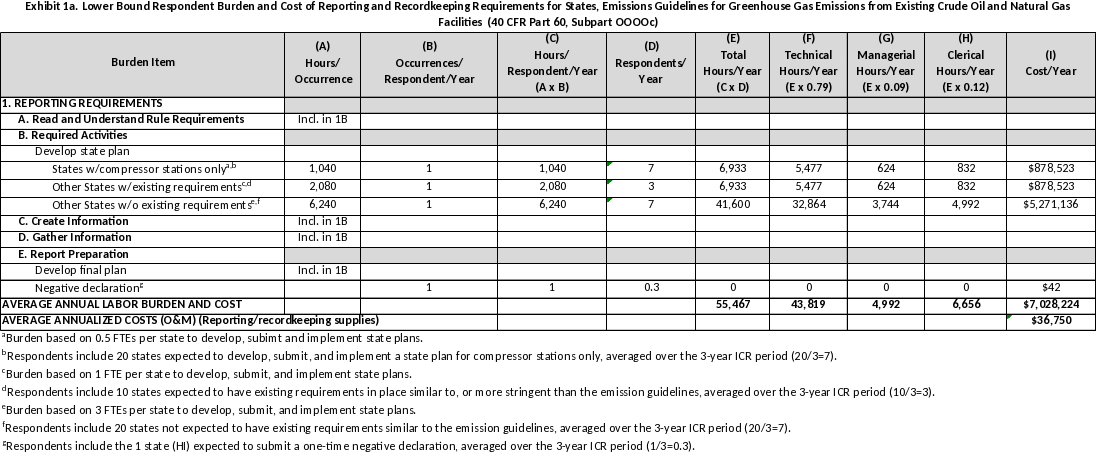
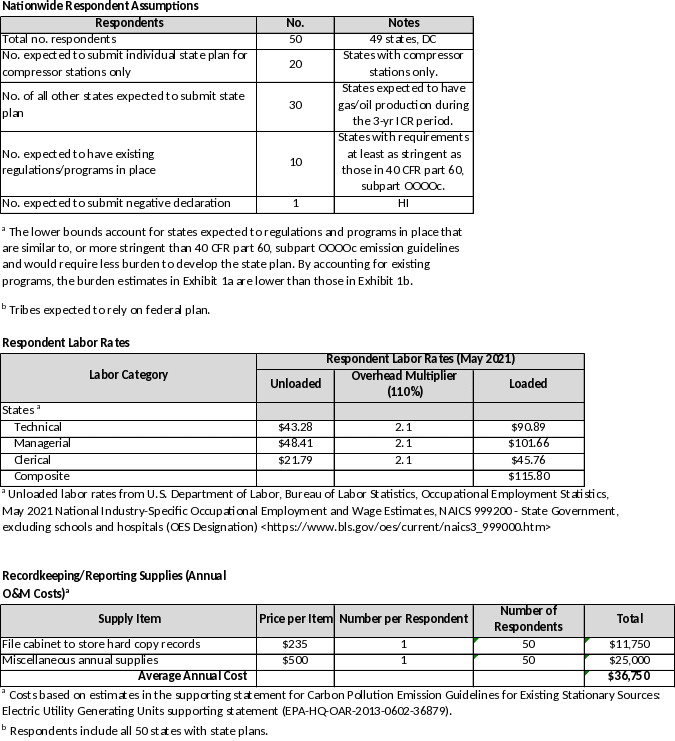
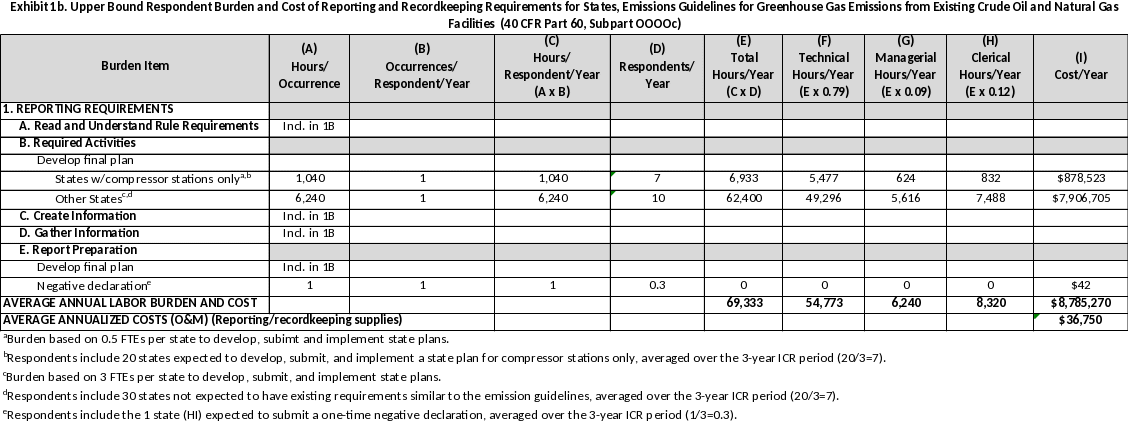

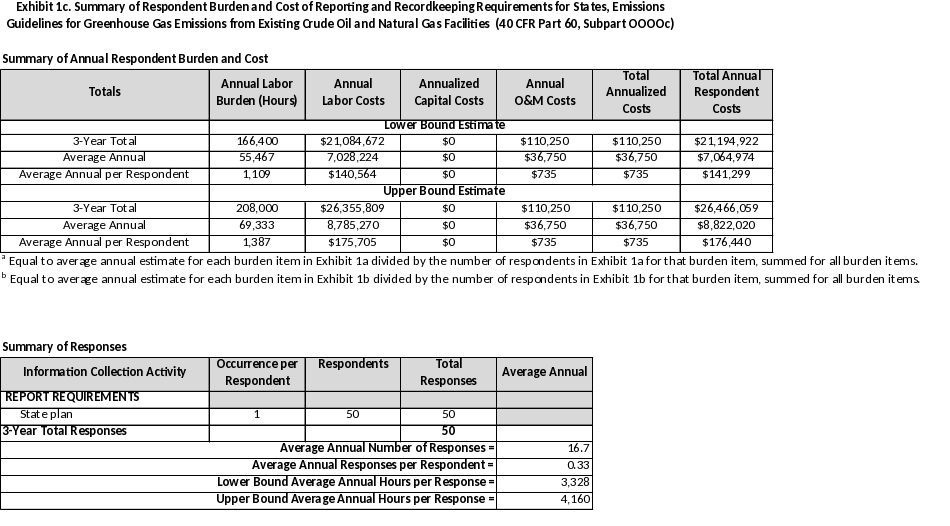
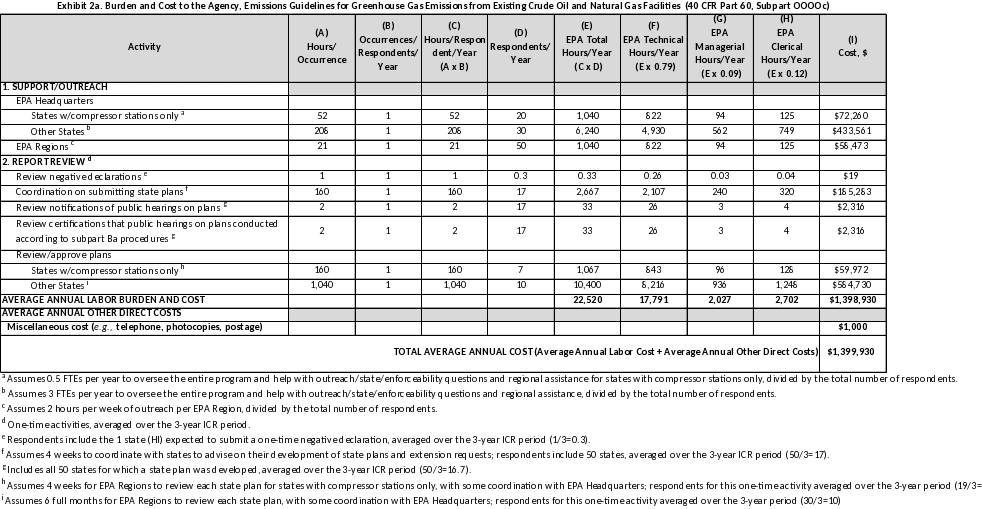
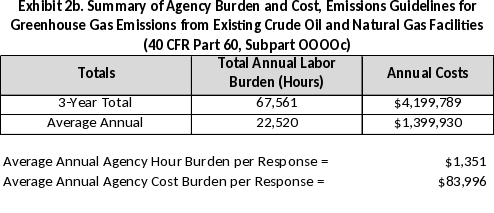
Appendix A
EPA’s Compliance and
Emissions Data Reporting (CEDRI) Interface

Appendix B
Instructions for submitting reports to the EPA via CEDRI per 60.5420b(c)(11):
(11) You must submit reports to the EPA via CEDRI, except as outlined below. (CEDRI can be accessed through the EPA's CDX (https://cdx.epa.gov/).) The EPA will make all the information submitted through CEDRI available to the public without further notice to you. Do not use CEDRI to submit information you claim as CBI. Anything submitted using CEDRI cannot later be claimed CBI. You must use the appropriate electronic report in CEDRI for this subpart or an alternate electronic file format consistent with the extensible markup language (XML) schema listed on the CEDRI website (https://www.epa.gov/electronic-reporting-air-emissions/cedri/). If the reporting form specific to this subpart is not available in CEDRI at the time that the report is due, you must submit the report to the Administrator at the appropriate address listed in §60.4. Once the form has been available in CEDRI for at least 90 calendar days, you must begin submitting all subsequent reports via CEDRI. The reports must be submitted by the deadlines specified in this subpart, regardless of the method in which the reports are submitted. Although we do not expect persons to assert a claim of CBI, if you wish to assert a CBI claim, submit a complete report generated using the appropriate form in CEDRI or an alternate electronic file consistent with the XML schema listed on the EPA’s CEDRI website, including information claimed to be CBI, on a compact disc, flash drive, or other commonly used electronic storage medium to the EPA. The electronic medium shall be clearly marked as CBI and mailed to U.S. EPA/OAQPS/CORE CBI Office, Attention: Group Leader, Fuels and Incineration Group, MD C404-02, 4930 Old Page Rd., Durham, NC 27703. The same file with the CBI omitted shall be submitted to the EPA via CEDRI. All CBI claims must be asserted at the time of submission. Furthermore, under CAA section 114(c), emissions data is not entitled to confidential treatment, and the EPA is required to make emissions data available to the public. Thus, emissions data will not be protected as CBI and will be made publicly available.
a For example, 40 CFR 60.5420b(a)(2) states that “If you are subject to state regulations that require advance notification of well completions and you have met those notification requirements, then you are considered to have met the advance notification requirements of this paragraph.”
b This table is not intended to be exhaustive, but rather represents a summary of potential notification, recordkeeping and reporting requirements affected facilities under proposed NSPS OOOOb could be subject to. Other notification, recordkeeping, and reporting requirements not listed in this table could also be required as specified in the proposed rule at 60.5320b(a)-(c).
c The three-year projection includes some new sources for 2021 and 2022 since 40 CFR part 60, subpart OOOOb would be in effect for new sources for which construction, modification or reconstruction commenced after November 15, 2021.
The proposed emission guidelines impose no new information collection burden on oil and natural gas facilities during the 3-year period of this ICR. The earliest timeframe for designated facilities to be in compliance is estimated to be December 31, 2027. A conservatively high estimate of the annual burden for industry is estimated to be around 2 million labor hours at a total annual labor cost of $166 million in 2027.
| File Type | application/vnd.openxmlformats-officedocument.wordprocessingml.document |
| File Modified | 0000-00-00 |
| File Created | 2024-07-27 |
© 2026 OMB.report | Privacy Policy